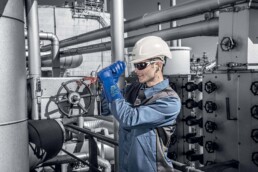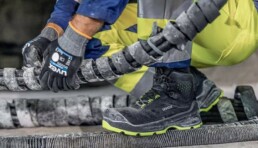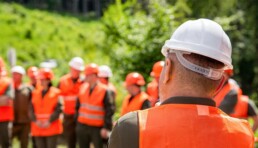Personal protective equipment refers to any type of equipment that is intended to be used or worn by workers for the purposes of ensuring their health and safety by protecting against hazards. This also includes any related additional equipment that serves the same purposes (Sec. 1, Para. 2 of the German PPE Usage Regulation, regulating the provision and use of PPE and providing practical guidelines for the implementation of EU Regulation 2016/425).
The use of personal protective equipment originates with the German Occupational Safety and Health Act (ArbSchG), according to which employers have a duty to improve the health and occupational safety of their workers in the workplace and to implement relevant protective measures (Sec. 3). This may take the form of replacing working techniques and materials (substitution), be of a technical or organisational nature or take place by means of protective clothing and other items of PPE. The protective measures required and the specific PPE to be worn at the workplace are set out in the risk assessment. Personal protective clothing and other protective equipment is designed to protect workers from injury and other hazards when at work. Since PPE at potentially hazardous workplaces is prescribed by law, the requirements, instructions of use and options for adaptation relating to this equipment are closely regulated. In this article, we answer common questions on the topic of PPE.
What counts as PPE?
PPE relates to the entire body from head to toe and also includes additional equipment designed to ensure the safety of workers such as fall protection and personal emergency signalling systems. Below is an overview of common forms of personal protective equipment with examples, as categorised by the German Occupational Insurance Association for Wood and Metal Industries (Berufsgenossenschaft Holz und Metall):
- Protective clothing: protective clothing, disposable protective suits and workwear
- Respiratory protection: respiratory protection masks, breathing connections, breathing apparatus and filtering devices
- Eye protection: safety spectacles, viewing panes etc.
- Head protection: safety helmets, hair covers, bump caps etc.
- Foot protection: safety, protective and occupational footwear, knee protection
- Hearing protection: hearing protection earplugs, earmuffs, otoplastics and combinations with other PPE components
- Hand and arm protection: cut, perforation and abrasion-resistant, heat, cold or chemical-resistant safety gloves and lower arm protection
Our range of PPE includes a variety of highly specialised products for all of the PPE categories mentioned above. PPE is also used for the following purposes too:
- Skin protection: skincare and cleaning products, UV protection products etc.
- Anti-fall protection: safety harnesses, anchor devices, connection components, fall shock absorbers, fall arresters etc.
- Height/depth rescue: rescue loops and harnesses, lifting devices
- Anti-drowning protection: life jackets, restraint belts, cold-water protection suits etc.
- Personal emergency signalling systems: portable personal emergency signalling devices with reception

When is it obligatory to wear personal protective equipment?
Whether PPE is necessary and obligatory at a specific workplace is determined by the risk assessment. This must be carried out by the employer or, in accordance with Sec. 13, Para. 2 of the German Occupational Safety and Health Act, by a commissioned reliable specialist. The responsible individual identifies, assesses and documents the hazards and risks to worker health and safety that are present at the specific workplace. The necessary protective measures are then derived based on this assessment. In general, in order to eliminate workplace hazards, technical and organisational measures must be implemented as a first step and before personal protective equipment is purchased and put into use. The decision as to which suitable PPE items should be purchased for the specific line of work lies with the employer or the safety officer. Occupational insurance associations also offer support with selecting appropriate PPE.
Who covers the costs for personal protective equipment?
In accordance with Sec. 3 of the German Occupational Safety and Health Act, employers have a statutory duty “to provide the necessary equipment”, which includes purchasing PPE and bearing the costs for workers. This applies to all items of PPE that the risk assessment deems necessary. If you would like to wear personal protective equipment on the grounds of a personal safety requirement that lies outside of the identified need, the costs for this will not be covered.
How can I identify certified personal protective equipment?
The CE marking on a PPE product indicates that it fulfils the EC directives and regulations applicable to this type of product. This marking also indicates that the product has passed the relevant resilience tests, the EU type examination and annual reviews (irrespective of the PPE category). You can find out which standards and guidelines are applicable to the individual product groups on our website. If a PPE product contains a CE marking, this also means that this product fulfils all the requirements provided by the EU PPE Regulation. For more information on the guidelines and safety provisions set out by the PPE Regulation (EU 2016/425), check out our blog article.
We recommend avoiding personal protective equipment available on online stores or in physical shops that doesn’t have any marking. Category III PPE products also have an additional four-digit number from the responsible certification body.
What are the categories for personal protective equipment?
PPE is divided into three different categories based on the severity of the hazards it offers protection from. Category I protective clothing protects against minor hazards and risks, whilst category III PPE protects against risks that may have fatal consequences or irreversible impacts on health. Category II covers all other PPE products that offer standard protection against mechanical hazards and that are adapted on an individual basis (individualised PPE).
Just as the protection provided by these three categories is different, so too are the control mechanisms. Category I PPE products undergo a production control at the manufacturer’s premises with the results recorded in a technical document. For category II, personal protective products have to undergo an additional EU type examination carried out by an external notified body. Meanwhile, PPE products classified as category III are not only subject to the two control methods mentioned above but are also subject to annual review by an external body. If the PPE product passes all of these tests and requirements, it receives the CE marking.
| Control mechanisms |
Production control with technical documentation (internal) | EU type examination (external) | Annual review (external) |
| Category I PPE |
x | ||
| Category II PPE |
x | x | |
| Category III PPE | x | x | x |
Personal protective equipment from uvex
On the uvex online shop, you can purchase personal protective equipment that offers head-to-toe protection and, depending on the model, also comes with a variety of different protective features.
If you are looking for personal protective equipment for your employees, our online shop for business customers is the place for you. If you’re wanting to purchase equipment privately, then the uvex group shop has everything you need. Our products are also available from several different retail partners. If you think you’ll prefer this option, then please get in touch with us via our contact form.

Head and face protection
Under safety helmets, you will find helmets in a variety of colours for different industries and applications, face guards and visors for eyes and face and bump caps to protect against falling objects and impact. Find out why the colouring of our personal protective equipment is so important by reading our blog article, “Colourful PPE (part 1 of 3): What is the significance of colours in PPE – how do they make working life easier?”
Eye protection
Safety spectacles can be subdivided into spectacles, overspecs and goggles. Depending on their tints, these spectacles and goggles offer protection from UVA and UVB rays as well as sunlight (glare protection). The majority of our safety spectacles are scratch-resistant and anti-fog and also have good additional chemical resistance. In contrast to traditional spectacles, goggles offer a very secure fit, which brings both enhanced comfort and protection. For some applications, it’s essential that no particles or splash whatsoever end up in the eyes.
Overspecs can be worn over your own prescription spectacles, providing wearers with optimal protection. Alternatively, uvex can also produce individualised safety spectacles adapted to your prescription.
Hearing protection
As for hearing protection, uvex proposes disposable and multi-use hearing protection earplugs, earmuffs – which, like over-ear headphones, cover the entire ear muscle –, banded ear protectors and hearing protection otoplastics. Otoplastics are hearing protection earplugs that have been individually moulded and manufactured for your individual ear canal, offering optimal fit and the best possible wearer comfort. For lots more interesting information on the importance and different types of hearing protection at uvex, check out our hearing protection guide.
Respiratory protection
Certified respiratory protection masks not only protect against viruses and bacteria but also shield against poisonous and harmful dust, aerosols, fungal spores as well as carcinogenic and radioactive substances. In many industries, these masks are crucial for ensuring long-term protection of the lungs and airways. The FFP1, FFP2 and FFP3 masks available in the uvex shop differ in terms of the harmful particles they filter, their filter performance and their maximum filter capacity. uvex also offers face masks – sometimes known as surgical masks. You can find more information about PPE respiratory protection masks on the relevant category pages.
Protective clothing and workwear
As we’ve mentioned, when it comes to clothes, there’s a distinction to be made between protective clothing (PPE) and workwear. Both categories include items such as jackets, vests, trousers and tops. In addition, you can also purchase disposable overalls for full-body PPE, underwear and functional garments, socks and firefighter changing coveralls from uvex too.
Hand protection
Depending on the model series, safety gloves protect your hands from cuts, penetration, extreme temperatures, impact and chemicals. They are also abrasion-resistant. With these essential protective features, the use of gloves is of primary importance for workers in the construction, automotive, metal and plastics industry as well as the chemical industry, on assembly lines and in other sectors too.
Foot protection
Occupational footwear and safety shoes are responsible not only for keeping your feet dry when working in wet environments but also helping you maintain firm footing. Safety footwear safeguards your feet against injuries that may occur due to falling objects or objects lying on the ground, sharp nails, broken glass etc. Further, foot protection also shields against impact, harmful substances that may penetrate shoes and hazards due to electrostatic discharge. To decide between S1, S2 and S3 safety footwear and O1 and O2 occupational footwear, you will need to consider your working environment and the hazard risks associated with it.
Can personal protective equipment be adapted to individual requirements?
Some of our protective clothing product groups are suitable for individualisation. We are able to add your prescription to safety spectacles and VDU spectacles, produce individually moulded otoplastics for hearing protection and adapt your safety footwear to fit your feet using orthopaedic solutions such as insoles and sole adjustments. Discover more information on this topic on our page “Individual PPE”.
Are instructions on how to use PPE correctly necessary?
In accordance with Sec. 12 of the German Occupational Safety and Health Act, employers have a duty to instruct their workers on how they can protect themselves when carrying out their specific professional activity at their workplace. This also applies when new working tools and technology are introduced. Sec. 3 of the German PPE Usage Regulation correlates the duty to inform and explain to the use of personal protective equipment – this applies to every item of supplied PPE. The German Social Accident Insurance (DGUV) adds in Sec. 4 “Instruction of the Insured Person” of DGUV Regulation 1, that the insured person must obligatorily receive instruction on the accident prevention regulations and the regulations of the accident insurance institutions relevant to the respective workplace.

Can personal protective equipment items be used by more than one person?
Pursuant to Sec. 2, Para. 2 of the German PPE Usage Regulation, individual PPE items should be adapted to one individual and not be used by other people. If use by multiple people cannot be avoided, the employer must ensure that no dangers to health or hygiene issues arise from this multiple use.
How often should you replace personal protective equipment?
In principle, PPE should be replaced as soon as it stops being functional; this means it should be replaced if it has suffered minor or major damage such as tears or holes or if the protective features are no longer guaranteed. In order to be able to identify this in time, workers should always inspect the components for visible defects and check the personal protective equipment is functioning well before using it. If you notice any defects, these should be reported immediately to the person responsible for PPE at your company. In addition, PPE should be subject to verification by a qualified specialist at least once a year. If an item of PPE has been repaired, it must be verified afterwards to ensure it provides full, effective protection before it is brought back into use. Disposable products such as disposable protective suits must be disposed of after use.
Buy personal protective equipment from uvex experts
uvex is your expert for personal protective equipment. We are committed to ensuring protection at the workplace and keeping you safe. As such, uvex safety develops highly functional, modern and premium PPE to give you comprehensive personal protective equipment all in one place. When you purchase personal protective equipment for your employees from our online shop, you can be sure that you are choosing certified quality products. Take a look at our blog article on “7 mistakes that you should definitely avoid when it comes to PPE” for advice on how to choose, use, care for and maintain your personal protective clothing and other PPE products.
Are you looking for personal protective equipment for the pharmaceutical industry or biotech sector? If so, check out our blog article, “PPE for the pharma and biotech industry – improved performance thanks to optimal uvex solutions”. Here, you’ll find tips on how to choose the right PPE for you. If you work in crop protection, our article “Pesticides – personal protective equipment for handling plant protection products” will be a useful resource for you. For those in the automotive industry, the article on “PPE for the automotive industry – protected from head to toe in the electromobility sector” is a must-read.
If you would like personal consultation on PPE, please don’t hesitate to get in touch by emailing us (serviceteam@uvex.de), giving us a call (+49 800 66 44 893) or using our contact form and we’ll be happy to help.